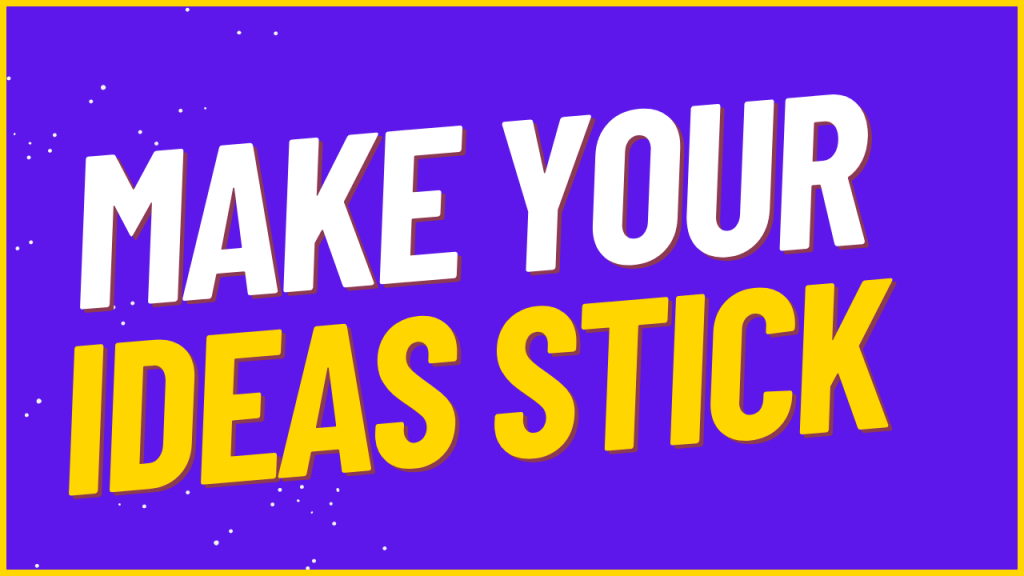As a writer, you will have an idea that you need to convey to your readers and that idea has to be”remembered”. If they do not remember what you said then you have not done your job correctly.

In this guide, we will discuss 6 ways to make your ideas stick:
- Simplicity
- Unexpected
- Visualized
- Credibility
- Emotions
- Tell A Story
Simplicity
The first step to making your idea “sticky” is to make it simple. A simple idea is easy to understand and remember. It is not bogged down by unnecessary details. It should not include details or parts that don’t actually add to your idea.
After you have written your idea, ask yourself these questions:
- What is the core message?
- What are the essential details?
- What can be removed?
- Is Characters too complicated?
- Will people unwarranted have more questions?
Unexpected
People are more likely to remember an idea that is unexpected. A surprising idea captures attention and sticks in the mind. It has to surprise people, if it’s something ordinary then people will not remember what you said.
To make your idea more unexpected, ask yourself the following questions:
- What are people not expecting?
- What are the counter-intuitive aspects of my idea?
- What are the unusual implications of my idea?
- Does it shock people?
- Will this have people “share” your copy because its very unexpected?
Visualized
An idea is more likely to “stick” if it is concrete. A concrete idea is easy to visualize and understand. It is not abstract or vague. One of the great ways to do this is by comparing the situation to something that your reader has already experienced.
To make your idea more concrete ask yourself the following questions:
- What can I show people?
- What can I make tangible?
- What can I make specific?
- Can People Relate?
Credibility
People are more likely to believe an idea if it is credible. A credible idea is believable and trustworthy. It is not far-fetched or implausible. This has to be done in a way that people don’t think it’s a show off. A good tactic is to use logos or bring credibility from third party that shows that the idea is legit and vetted.
To make your idea more credible, Ask yourself the following questions:
- Who is my audience?
- What do they already believe?
- What would make them more likely to believe my idea?
- Is there any elements of credibility?
Emotions
An idea is more likely to “stick” if it evokes emotions. Emotional ideas are more memorable and persuasive. They are not dry or boring. A good idea will add or subtract an emotion. You need to either add joy, subtract sadness or some sort of emotion.
Diffrent Types of emotions:
Happiness, sadness, anger, fear, love, hatred, jealousy, envy, compassion, remorse, satisfaction, pride, contentment, relief, gratefulness, hope, amusement, satisfaction, shyness, embarrassment, guilt, shame, worry, stress, anxiety, panic, boredom, interest, excitement, joy, elation, contentment, satisfaction, relief, proud, shy, guilty, stressed, anxious, interested, excited, joyful, elated.
To make your idea more emotional, Ask yourself the following questions:
- What emotions does my idea evoke?
- What are the potential objections to my idea?
- How can I make my idea more appealing?
Tell A Story
People are more likely to remember an idea that is presented as a story. A story is more engaging and persuasive than a list of facts. It is also more likely to “stick” in the mind.
A story should have a beginning, middle, and end. It should also be concrete and specific.
Example Story:
A friend of friend of ours is a frequent business traveler. Let’s call him Dave. Dave was recently in Atlantic City for an important meeting with clients. Afterward, he had some time to kill before his flight, so he went to a local bar for a drink.
He’d just finished one drink when an attractive woman approached and asked if she could buy him another. He was surprised but flattered. Sure, he said. The woman walked to the bar and brought back two more drinks—one for her and one for him. He thanked her and took a sip. And that was the last thing he remembered.
Rather, that was the last thing he remembered until he woke up, disoriented, lying in a hotel bathtub, his body submerged in ice.
He looked around frantically, trying to figure out where he was and how he got there. Then he spotted the note: don’t move. call 911.
A cell phone rested on a small table beside the bathtub. He picked it up and called 911, his fingers numb and clumsy from the ice. The operator seemed oddly familiar with his situation. She said, “Sir, I want you to reach behind you, slowly and carefully. Is there a tube protruding from your lower back?”
Anxious, he felt around behind him. Sure enough, there was a tube.
The operator said, “Sir, don’t panic, but one of your kidneys has been harvested. There’s a ring of organ thieves operating in this city, and they got to you. Paramedics are on their way. Don’t move until they arrive.”
This story has all the elements that we spoke about in the article. Can you guess what they are?

